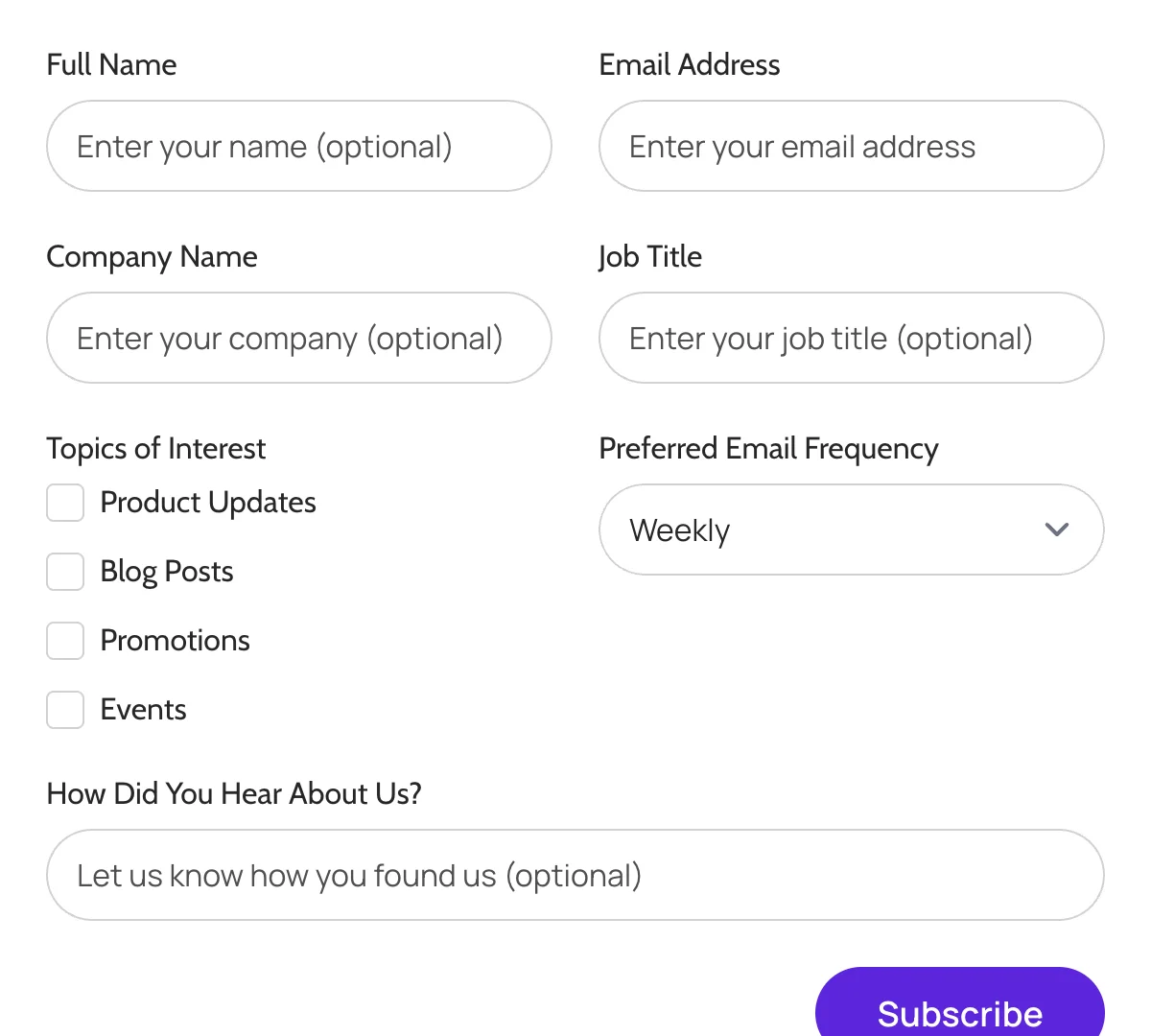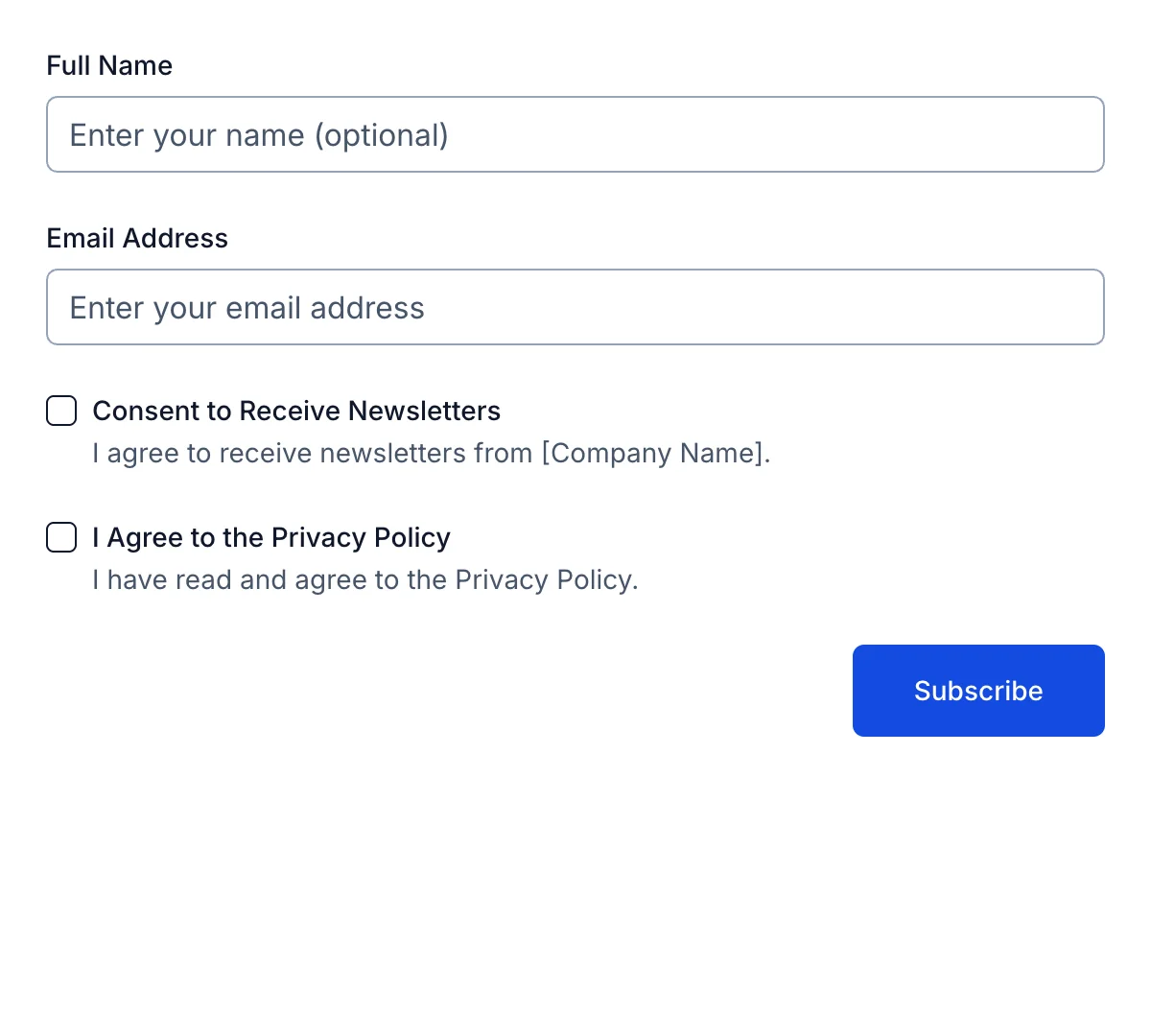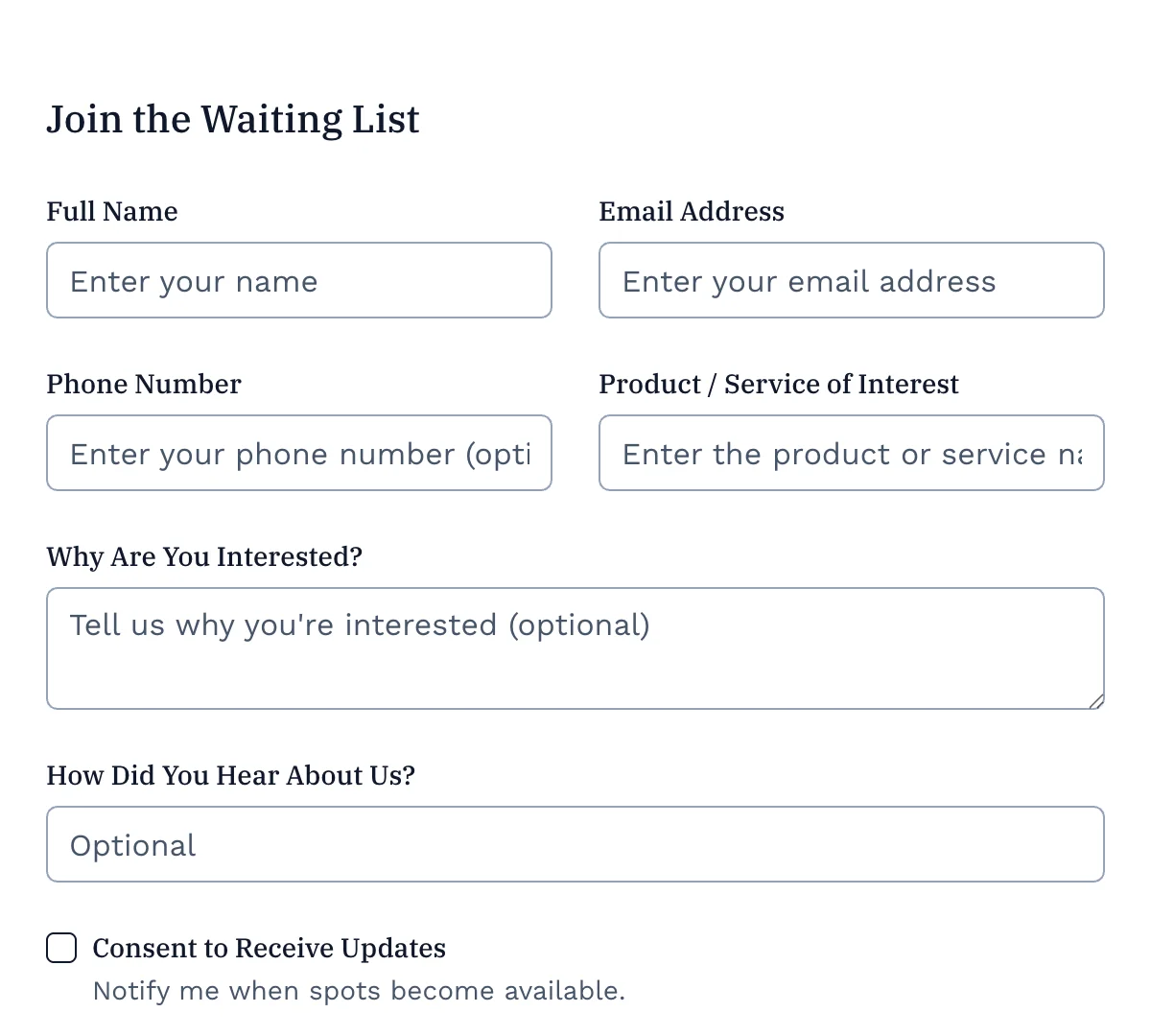Signup Forms
Clean, effective signup form for growing your audience or user base.
-

Email Signup Form
Clean email signup form for capturing subscribers and building engagement.
Get code -

Mailchimp Signup Form
Clean, efficient Mailchimp signup form for growing your mailing list.
Get code -

Klaviyo Signup Form
Clean Klaviyo signup form for seamless email marketing automation.
Get code -

Newsletter Signup Form
Clean, minimal newsletter signup form for growing your readership.
Get code -

Waiting List Form
Clean, focused waiting list form for capturing early interest and leads.
Get code
What is a Signup Form?
Signup forms are simple, user-facing forms designed to collect essential contact information (like an email address) from individuals who opt in to receive updates, join a waitlist, or subscribe to a newsletter. Whether it’s for early product access, exclusive content, or regular updates, signup forms act as the first step in building a direct relationship with your audience.
These forms play a crucial role in audience growth, lead generation, and long-term marketing success. By capturing user interest at the right moment, signup forms help convert anonymous visitors into engaged subscribers. They are especially effective when paired with compelling calls to action and placed strategically throughout your website to maximize visibility and conversions.
Core Elements of an Effective Signup Form
At a minimum, a signup form should include an email address field. You might also ask for a first name to personalize future emails, but keeping the form short reduces friction. For more tailored content, optional fields such as interests or preferences can provide valuable segmentation data.
Clarity is key. A signup form should clearly communicate the value of signing up; whether it’s a monthly newsletter, exclusive discount, or early access to features. Always include a privacy statement and consent checkbox to comply with GDPR or other data protection laws. Transparency builds trust and ensures you’re building a high-quality list of engaged users.
Placement and Visibility of Signup Forms
The success of a signup form depends heavily on where and how it’s presented. High-performing locations include your homepage, blog sidebar, footer, and dedicated landing pages. These areas tend to attract high-intent users and provide consistent visibility.
Beyond static placements, consider using pop-ups, slide-ins, or exit-intent modals to capture attention at key engagement points. You can also embed contextual signup forms within relevant blog posts or near downloadable lead magnets. The goal is to present the signup form when user interest is highest, without being intrusive.
UX/UI Best Practices for Signup Forms
Good form design is one of the most critical factors in improving signup conversions. A clean, minimal interface encourages users to complete the form without hesitation or distraction. To design an effective signup form, keep the following practices in mind:
- Limit the number of fields: Ask only for what’s necessary, usually just an email address. Additional fields increase friction.
- Use a clear, action-oriented CTA: Phrases like “Get Updates” or “Join Free” convert better than generic buttons like “Submit.”
- Write concise, benefit-focused copy: Let users know exactly what they’ll get by signing up.
- Design for mobile and accessibility: Ensure your form is responsive, keyboard-navigable, and uses readable font sizes and proper contrast.
- Avoid distractions: Remove unnecessary animations, auto-playing media, or pop-ups near the form that might derail focus.
Even small design changes can significantly impact signup rates. Make sure the form aligns visually with the rest of your site while still standing out enough to catch the user’s eye.
Incentives and Lead Magnets in Signup Forms
Users are far more likely to provide their email address if there’s a clear benefit in doing so. That’s where lead magnets come in. A well-crafted incentive, like a downloadable checklist, exclusive discount, or early access invitation, can double or even triple signup rates when presented clearly and at the right moment.
What matters most is relevance. The incentive should speak directly to the user’s interests or immediate needs. For example, offering a free resource tied to your product or blog content works better than a generic freebie. Placement also matters; mention the incentive near the form but don’t overshadow it. You want the user’s attention on both the offer and the action required. Finally, always deliver on your promise quickly. Whether it’s through an auto-response email or a redirect to a download page, fast fulfillment helps build trust and keeps new subscribers engaged.
Social Proof and Trust Signals in Signup Forms
Trust is often the deciding factor when someone considers submitting their email. Even a simple signup form benefits from small but strategic trust signals that reassure users their data will be handled respectfully and that others have found value in signing up before them.
One effective tactic is to include social proof near the form. This could be a line stating how many people have already joined (“Over 5,000 subscribers and counting”) or a brief testimonial from a satisfied user. If you’re offering gated content or product access, a quote highlighting its usefulness can add credibility.
It’s also important to address privacy concerns. A short line like “We never spam” or “Unsubscribe anytime” can help with easing hesitation. Of course, you need to make sure you follow through on your promise as well.
Linking to your privacy policy reinforces transparency, and placing recognizable trust badges (especially if you’re collecting more than just an email) can further boost confidence.
Confirmation and Onboarding After Signup
What happens after a user submits your signup form is just as important as the form itself. A smooth, reassuring confirmation experience builds trust and sets the tone for future interactions.
Start by deciding whether to use a single opt-in (where the user is added immediately) or a double opt-in (where they confirm their email via a follow-up link). Double opt-in helps maintain a high-quality list but adds a small amount of friction.
Immediately after signup, consider showing a thank-you message or redirect the user to a confirmation page that sets clear expectations: what content they’ll receive, how often, and when to expect the first message. This is also a great moment to reinforce your value, share popular resources, or offer a next step like following on social media.
A welcome email should follow promptly. This first message can introduce your brand, offer a summary of what’s to come, and even include a small bonus or surprise. If you’re using an onboarding sequence, this is where it starts: guiding new subscribers through a few key emails that build familiarity and engagement over time.
Personalization and Segmentation via Signup Forms
Signup forms aren’t just about collecting contact details, they’re also an opportunity to gather insights that can make your communication more relevant and effective. Even a single extra field asking about user interests, content preferences, or role (e.g., “Are you a developer or a designer?”) can provide enough context to personalize your outreach.
Personalization starts with tagging or segmenting subscribers based on the data they provide. This allows you to send targeted emails that speak directly to their needs. Over time, this kind of tailored communication leads to better engagement and fewer unsubscribes.
For more advanced use cases, you can display dynamic forms based on user behavior or referral source. For instance, a visitor coming from a blog post about security might see a signup form offering a security-focused whitepaper, while someone from your pricing page might get a “Get notified about discounts” prompt.
The more relevant your form and follow-up, the more likely users are to convert and stay engaged. Just make sure to balance usefulness with simplicity.
Waiting List Signup Forms: Special Considerations
Waiting list signup forms are commonly used for upcoming launches, limited-access products, or exclusive events. Unlike standard newsletter forms, these are meant to generate excitement and convey urgency while capturing high-intent leads.
To create an effective waitlist form:
- Highlight exclusivity with phrases like “Limited spots available” or “Be the first to try it.”
- Keep it focused. Ask for just one or two fields (email, name) and a clear call to action.
- Explain what users are signing up for, including timelines, access details, or eligibility.
Once users submit the form, follow up immediately with a confirmation message that outlines next steps. Maintaining interest is critical, especially if users are waiting days or weeks. You can do this by:
- Sending occasional teaser emails about the product or event.
- Sharing progress updates (“We’re 80% through development!”).
- Offering refer-a-friend incentives to grow your waitlist organically.
Integrations and Automation for Signup Forms
Modern signup forms don’t just collect emails; they trigger workflows, sync with marketing tools, and power personalized experiences. Integrating your form with the right platforms ensures that every signup is automatically captured, categorized, and nurtured without manual intervention.
Most commonly, signup forms connect to email marketing services like Mailchimp, ConvertKit, or MailerLite to automate welcome sequences and drip campaigns. You can also integrate with CRMs like HubSpot or Salesforce to track subscriber interactions or sync user data. For teams working in tools like Notion, Airtable, or Google Sheets, form submissions can be instantly logged for team-wide visibility.
To take it further, automation platforms like Zapier or webhook triggers allow signup forms to kick off complex workflows, like tagging users based on preferences, notifying your team on Slack or Discord, or even initiating Stripe payment flows for gated access.
Formspree supports all these integration types. You can easily connect your signup form to dozens of tools, trigger real-time email notifications, sync data with your CRM, and automate follow-up sequences—all without writing server-side code. This allows you to create a signup experience that’s not just efficient, but also scalable and personalized.
Analytics and Optimization of Signup Forms
Tracking how users interact with your signup forms is important for improving performance over time. By measuring key metrics like form views, submission rates, and traffic sources, you can identify what’s working and where users are dropping off.
A/B testing is a simple but powerful way to optimize forms. You can experiment with different headlines, button text, form placement, or even incentives to see what drives higher conversions. It’s also helpful to analyze performance across devices. Many forms perform well on desktop but suffer on mobile.
To reduce abandonment, consider tactics like exit-intent popups or reminders for partially completed forms. Over time, even small improvements can lead to significant growth in your subscriber base.
Common Mistakes in Signup Forms and How to Avoid Them
Even well-intentioned signup forms can fall short if a few common pitfalls aren’t addressed. Here are key mistakes to watch out for and how to fix them:
- Asking for too much information: Long forms with unnecessary fields create friction and lower completion rates. Stick to essentials unless extra data is absolutely necessary.
- Using vague or weak value propositions: Generic copy like “Sign up for updates” doesn’t motivate users. Clearly explain what subscribers will receive and why it matters to them.
- Neglecting mobile optimization: A form that looks great on desktop might be unreadable or hard to use on a phone. Always test responsiveness and tap-target sizing on mobile devices.
- Failing to confirm or onboard new subscribers: Not sending a thank-you message or welcome email leaves users wondering what’s next. Set expectations and deliver immediate value post-signup.
- Overlooking accessibility and usability: Forms without proper labels, keyboard navigation, or sufficient color contrast exclude many users. Build with accessibility in mind from the start.
- Ignoring analytics and optimization: Without tracking performance or testing alternatives, it’s difficult to improve results. Use A/B tests and form analytics to refine what works.
Conclusion
Signup forms are important for growing your audience, building anticipation, and creating lasting user relationships. From form design and placement to incentives, onboarding, and optimization, every element plays a role in conversion and trust.
Using a flexible platform like Formspree makes it easy to build high-converting signup forms, integrate with your favorite tools, and automate your workflows. Get started with a prebuilt Formspree template and start collecting signups on your site in minutes!